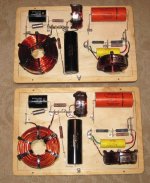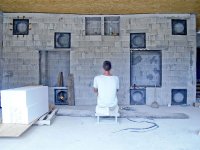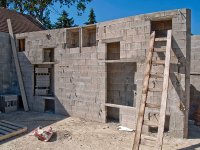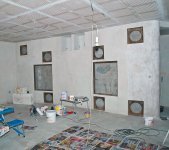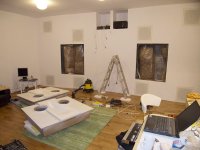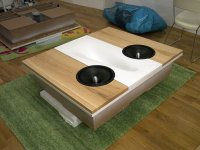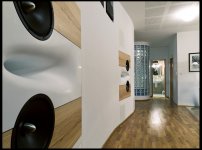Lynn, I suppose in your case with lazy ribbon - the radiated power /and this is perceived at UHF/ of lazy ribbon is roughly equal of radiated power of Azura at XO, although polar are different shape. Thats why you have less pain with integration.
That is a very good point. Just by accident, the effective radiating area of the AH425 and the large RAAL are fairly similar in the 7~10 kHz range. The AH425 mimics a direct-radiator of about 3~4" diameter at those frequencies, which in turn sets the HF directivity index (DI). The RAAL ribbon is about 10" high and 0.5" wide, so the emissive area isn't all that different.
Although the polar patterns have a different shape, the overall directivity index is fairly similar. This probably results in a gentler hand-off between the two drivers than the more typical scenario of a tiny 2" supertweeter matched to a large-format horn - the horn is really directive at the top of its working range, while the compact supertweeter is radiating into a full 90-degree angle. Abrupt deviations in DI are usually audible as discontinuities in the spectrum, or at the least, a shift in spatial perspective that is frequency-dependent.
For that matter, the transition between the single 15" bass driver and the freestanding 16.5" Azurahorn is also simple, with a crossover in the 630~700 Hz range and similar directivity indexes from both drivers.
I might at some point consider a pair of 15" drivers, but if I try that, I think I'll put them side-by-side, just under the horn, and lower the crossover a bit (or use a larger horn).
Changing topics, there is a small chance that the problematic supertweeter integration in your system is an artifact of the HF power amplifier. I have had power amplifiers give the false impression of a bad or defective tweeter before - they can sound rather alike, and you're never completely sure until you try a different type of power amplifier.
One of the nastier aspects of multi-amped systems are power amplifiers with dissimilar characters for different drivers - so you're not sure that XYZ driver sounds "dry" or "wet" or if it's just the sound of the amplifier. Unlike drivers, Class AB amplifiers change distortion spectra with decreasing level, so the sonic character can change with crossover settings and musical dynamics. If the amplifier is doing this, subjectively balancing a multi-amped system can be almost impossible, since the sound of the amplifiers themselves are level-dependent.
With a single amplifier driving the complete loudspeaker, it's easy to tell if the power amplifier is a bad actor - just swap it out and see what changes. Any amplifier colorations that occur are applied to the entire loudspeaker.
With a multi-amped system, the number of potential amp/speaker colorations is very large, when combined with active crossover level-setting and frequency adjustments. Is it the amplifier, or does the level need to come down 0.5 dB, or the HF crossover moved from 7 to 8 kHz?
Last edited:
It's enough of a hassle designing direct-heated triode PP amplifiers along with matching loudspeakers. The thought of a multi-amped system where I have to design multiple Class A amplifiers, along with all-vacuum-tube crossovers, is just too much. I have to draw the line somewhere.
I've been designing amplifiers long enough to be resigned to the fact that "uncolored" amplifiers do not exist, and might possibly never exist. They all have a sound - admittedly, it's not easy to recognize the colorations until you've designed a few for yourself. Then the "electronic" colorations become a lot more noticeable, and plenty annoying. Consider yourself lucky if you don't hear amplifier colorations.
Some amplifiers are better than others; some are worse, and there are very strange amp-speaker interactions that almost exactly mimic the sound of bad drivers. Amplifier colorations tend to be level-dependent, and colorations are typically in the mids and highs - the more zero-crossings and potential for current-slewing events, the more trouble there is.
I get around this by combining all-Class-A operation with very high slew rates and devices selected for the lowest possible inherent distortion. That doesn't make me a genius; it's just the easy way out. It also limits power to the 20~30 watt range.
I've been designing amplifiers long enough to be resigned to the fact that "uncolored" amplifiers do not exist, and might possibly never exist. They all have a sound - admittedly, it's not easy to recognize the colorations until you've designed a few for yourself. Then the "electronic" colorations become a lot more noticeable, and plenty annoying. Consider yourself lucky if you don't hear amplifier colorations.
Some amplifiers are better than others; some are worse, and there are very strange amp-speaker interactions that almost exactly mimic the sound of bad drivers. Amplifier colorations tend to be level-dependent, and colorations are typically in the mids and highs - the more zero-crossings and potential for current-slewing events, the more trouble there is.
I get around this by combining all-Class-A operation with very high slew rates and devices selected for the lowest possible inherent distortion. That doesn't make me a genius; it's just the easy way out. It also limits power to the 20~30 watt range.
Last edited:
One last distraction, then back to our regularly scheduled programming:
Note the inductor orientations in our crossovers are nearly identical. Admittedly, I only used measurement, not my ears (they would fail me), but it appears there is safety in numbers. If addressing the question of pickup from the voicecoil/magnet, you also get a third dimension (vertical spacing) to play with, making it even easier.
Caps are glued with a flexible RTV, instead of the foam idea.
Note the inductor orientations in our crossovers are nearly identical. Admittedly, I only used measurement, not my ears (they would fail me), but it appears there is safety in numbers. If addressing the question of pickup from the voicecoil/magnet, you also get a third dimension (vertical spacing) to play with, making it even easier.
Caps are glued with a flexible RTV, instead of the foam idea.
Attachments
Very similar, and a lot better than what you see in high-end $80,000 speaker systems.
You also have the good taste to avoid those awful-sounding flat-pack inductors. Why anyone ever got the idea that packing an inductor with nasty-sounding plastic between the layers is a mystery to me. A conventional air-core inductor wound with (relatively) oxygen-free wire has almost zero (subjective) coloration, which is a lot better than nearly any capacitor. Not sensitive to microphonics, either.
Use good-quality wirewound resistors with a generous power rating and you are good to go.
You also have the good taste to avoid those awful-sounding flat-pack inductors. Why anyone ever got the idea that packing an inductor with nasty-sounding plastic between the layers is a mystery to me. A conventional air-core inductor wound with (relatively) oxygen-free wire has almost zero (subjective) coloration, which is a lot better than nearly any capacitor. Not sensitive to microphonics, either.
Use good-quality wirewound resistors with a generous power rating and you are good to go.
Last edited:
This can be avoided with passive crossovers.
I have been toying with autoformers on my compression drivers and supertweeters in an otherwise purely active setup, and even a very cheap unit like the ones from parts express give very good results (with a very slight attenuation in the UHF that can be easily compensated for).
If set around -9dB or lower, the measured distortion, that mainly comes from the amplifier with normal A/B or D designs and well designed compression drivers or supertweeters, is really reduces with the autoformer, and the noise floor is also lowered by that much.
Last edited:
Since discussion that i started moves on. I attach picture of my system.
Tom, do you have more pictures? Those are gorgeous looking.
I guess I recognize AE Speakers woofers (how big?). Which horns are those? Jzagaja's? Or something custom?
Thanks!
Tom, do you have more pictures? Those are gorgeous looking.
I guess I recognize AE Speakers woofers (how big?). Which horns are those? Jzagaja's? Or something custom?
Thanks!
Thanks
Hi these are TD12M - and horns are custom - with build in Toe-in. Part of toe in is curvature of wall and part is in horn. Speaker baffle you see is 120x100cm.
There is also 4x 15inch per side for lowest octave. - under the cloth grills.
An other request for Tomtom:
can you extend the discussion a little bit towards the eventual qualities (and trade offs) of such a flush mounted system. I mean the supposed absence of diffraction, the 2 Pi space radiation and everything related having measurable or preferably audible consequences. I already see that the toe in is embedded.
I believe that Mr Olson will not report you for hijacking, and bravo for either the concept and the innovative aesthetics.
can you extend the discussion a little bit towards the eventual qualities (and trade offs) of such a flush mounted system. I mean the supposed absence of diffraction, the 2 Pi space radiation and everything related having measurable or preferably audible consequences. I already see that the toe in is embedded.
I believe that Mr Olson will not report you for hijacking, and bravo for either the concept and the innovative aesthetics.
Just read your post of a couple of years ago. I suppose only a hand full or two persons have such a system. End of 2003 I bought his last System 16 (Epsilon Reference) made after that he made one or two more System 12 and 5.Any body but me hear a Nestorovic Labs system 16? Or, even a system 5? Neither had any trouble with large format symphonic material, or small format Jazz. Rock, not so great, but then rock never entered into the equation.
I was the development engineer for 5 years, for system alterations and I built and thoroughly tested every system. Standard was a 1 1/2 db variation in FR between paired systems, at any given point, and a 3 db envelope. The system 16 sub woofers were capable of 106 db at 16 Hz, with 1 kHz just 3 db astray from that from physically separate satellite speakers.
I positioned the system exactly how Mile told me do (distance to the front wall as well as between subwoofers and Satellites) and I made professional room treat done so that without electronic correction the frequency response from 50 Hz to 20kHz at the sweet spot is within +-4 db. If I wish I would be able to put it down to +-3 db. I hear mostly large orchestral or organ music (Bruckner, Mahler, Shostakovich, Berlioz) and I am very frequently in concert halls. The soundstage and ambiance are just very special, I really don't know how Mile could do such loudspeakers with these kind of characteristics. One thing I learnt is that they are sensible to the attached electronics. I had a lot of discussions with him about preamps and other equipments.
Hi all,
Firstly Lynn, i hope that you are comfortable with publishing detail about my system in your thread. When its problem i ask moderator to move it.
System was build-in in new house. Actually it is house around speaker. The listening room is also main living room with kitchen as i dont want to separate from family. This room has no parallel walls. Its about 7x6x3m /W/D/H/ Wall are concrete but roof is light wood construction transparent to everything below ca 150hz - this was to suppress some of room modes. Room is normal furnished and only ceiling is threated with absorptive dry wall + ca 20 cm mineral wool. The room is reasonable live.
Speaker wall is hollow wall with internal volume about 1800L per side. This serve as enclosure for bass /subbass speakers/. Wall is 10cm concrete with steel reinforcement. This wall is also structural part of house as it support roof. Main cabs are MDF.
I was quite busy with house building that i havent much time to take photo.
I attach some photos that i hope are clear enough.
The biggest compromise i made was that room and listening position isnt totally symmetric in room. It was due other purposes of room. I was hoping that side walls are far enough and system directive enough to not to be a problem and i was right.
As how system sound.
Its definitely not MBL omni-polar type of sound. You have very clear window to recording but very little psycho-acoustical help from reflection to create this sense of ambient that omni are capable of.
Sound image is big and you are immersed in recording. Phantom center image is "as discrete center" stable - but of course only in sweet spot, it is stereo after all. You are definitely not capable to identify speakers as source of sound they are transparent.
In direct comparison with superb direct radiator freestanding speakers in same room that was ideally placed about 1,5m from rear wall was clear that rear reflection give to sound some positive richness. But reproduction was also less clear and more even from recording to recording.
So conclusion:
Very very good window to recording. Fantastical for monitoring. Less rich presentation than system with GOOD rear reflection.
Simple recording with ambient are fantastical but you instantly hear when they multimike and or put mikes too close to some orchestra section and that change timbre too much...
System is working in progress. I have not final amps. I was experimenting with STW /i canceled it after 1/2 year/. Its not decided whether i use DSP or analog line level. It was planed analog - i dont need delay - horn has exact depth i need to delay compression driver. But so far i dont see DSP as bottleneck. With final AMPs i will see. I listen only digital no turntable. Mostly classical. Oh, XO is 50 and 500 ca 48db/oct but quite assymetrical.
Thanks for positive comments and feel free to ask
Firstly Lynn, i hope that you are comfortable with publishing detail about my system in your thread. When its problem i ask moderator to move it.
System was build-in in new house. Actually it is house around speaker. The listening room is also main living room with kitchen as i dont want to separate from family. This room has no parallel walls. Its about 7x6x3m /W/D/H/ Wall are concrete but roof is light wood construction transparent to everything below ca 150hz - this was to suppress some of room modes. Room is normal furnished and only ceiling is threated with absorptive dry wall + ca 20 cm mineral wool. The room is reasonable live.
Speaker wall is hollow wall with internal volume about 1800L per side. This serve as enclosure for bass /subbass speakers/. Wall is 10cm concrete with steel reinforcement. This wall is also structural part of house as it support roof. Main cabs are MDF.
I was quite busy with house building that i havent much time to take photo.
I attach some photos that i hope are clear enough.
The biggest compromise i made was that room and listening position isnt totally symmetric in room. It was due other purposes of room. I was hoping that side walls are far enough and system directive enough to not to be a problem and i was right.
As how system sound.
Its definitely not MBL omni-polar type of sound. You have very clear window to recording but very little psycho-acoustical help from reflection to create this sense of ambient that omni are capable of.
Sound image is big and you are immersed in recording. Phantom center image is "as discrete center" stable - but of course only in sweet spot, it is stereo after all. You are definitely not capable to identify speakers as source of sound they are transparent.
In direct comparison with superb direct radiator freestanding speakers in same room that was ideally placed about 1,5m from rear wall was clear that rear reflection give to sound some positive richness. But reproduction was also less clear and more even from recording to recording.
So conclusion:
Very very good window to recording. Fantastical for monitoring. Less rich presentation than system with GOOD rear reflection.
Simple recording with ambient are fantastical but you instantly hear when they multimike and or put mikes too close to some orchestra section and that change timbre too much...
System is working in progress. I have not final amps. I was experimenting with STW /i canceled it after 1/2 year/. Its not decided whether i use DSP or analog line level. It was planed analog - i dont need delay - horn has exact depth i need to delay compression driver. But so far i dont see DSP as bottleneck. With final AMPs i will see. I listen only digital no turntable. Mostly classical. Oh, XO is 50 and 500 ca 48db/oct but quite assymetrical.
Thanks for positive comments and feel free to ask
Attachments
Member
Joined 2003
Curious how you made the horns, and what profile worked out for you. I must say building an entire room around a set of loudspeakers is extraordinarily ambitious!
Certainly different from 2x4, 2x6, wood framing, and prefab wallboard used in the USA. I think the real reason Americans like bass-heavy and loud speakers are the losses through the walls, which are not as rigid as European and Asian concrete block with steel reinforcement.
We get occasional 100~120 mph winds here in Colorado, but construction technique is the same as the other Western parts of the USA - just more solid, in order to withstand the -15F winters and the high winds. The style of construction used on the West Coast - California, Oregon, and Washington - is simpler and more lightweight, since they don't have the extremes of weather that we have here (40F temperature change in a 24-hour period is not unusual).
Certainly different from 2x4, 2x6, wood framing, and prefab wallboard used in the USA. I think the real reason Americans like bass-heavy and loud speakers are the losses through the walls, which are not as rigid as European and Asian concrete block with steel reinforcement.
We get occasional 100~120 mph winds here in Colorado, but construction technique is the same as the other Western parts of the USA - just more solid, in order to withstand the -15F winters and the high winds. The style of construction used on the West Coast - California, Oregon, and Washington - is simpler and more lightweight, since they don't have the extremes of weather that we have here (40F temperature change in a 24-hour period is not unusual).
Last edited:
- Home
- Loudspeakers
- Multi-Way
- Beyond the Ariel
